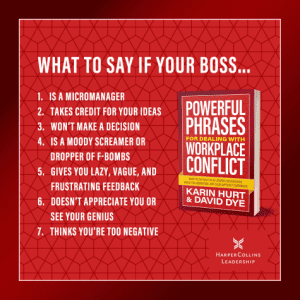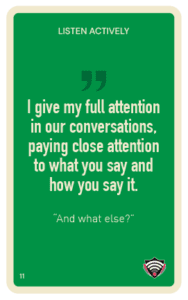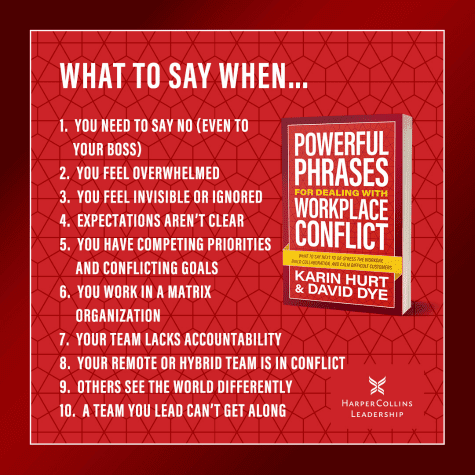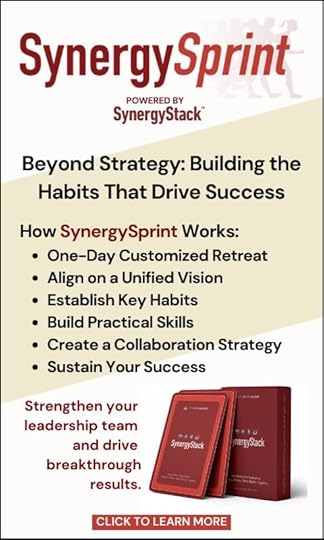David Dye's Blog, page 11
January 31, 2025
How do I build a better relationship with my difficult (icy) boss?
You know the type: the difficult boss barely acknowledges you, keeps conversations strictly transactional, and never lets you see their human side. Frustrating right?
But here’s the thing: their iciness may not be about you.
Maybe they’re overwhelmed, introverted, or just wired differently than you.
Instead of taking their frostiness personally, let’s get strategic. You have more power to shape this relationship than you think.

It’s tempting to assume a cold boss is unfriendly or uninterested—but what if they’re juggling too much or unsure how to connect? Instead of filling in the blanks with worst-case scenarios, open the door to understanding.
 Try this simple yet powerful phrase:
Try this simple yet powerful phrase:
👉 “I’m curious how this looks from your perspective.”
This phrase, inspired by G.O.A.T. #7 from Powerful Phrases for Dealing with Workplace Conflict, shifts the focus from judgment to curiosity. It signals that you value their viewpoint and invites them into a real conversation—not just another work exchange.
More tips in the video… plus you won’t want to miss the ice sculptures from the Breckenridge International Snow Sculpture Championships).
Take the Lead in Building ConnectionEven the most distant leaders care deeply about something. It could be their career, the company’s results, or even just one aspect of the job. Pay attention to what makes them light up. Do they get more engaged when talking about data? Do they open up more in one-on-one settings?
Once you spot a pattern, use it to bridge the gap. A great way to do this? Another G.O.A.T. phrase:
👉 “What would a successful outcome do for you?”
This simple question shows you’re invested in their goals. And when they feel seen, you’re more likely to get the engagement and respect you’re looking for.
Offer to Help—And Bring the Team TogetherOne of the best ways to soften a tough boss? Create an environment where connection naturally happens.
You might…
 Offer to lead a team-building exercise. Suggest adding a few minutes in meetings for informal connection (see a list of Compassionate Conversation Starters)
Offer to lead a team-building exercise. Suggest adding a few minutes in meetings for informal connection (see a list of Compassionate Conversation Starters) Bring small, practical habits into daily work—like recognizing colleagues for wins.Would it be nice if your boss took the lead on this? Sure. But waiting for them to change won’t get you anywhere. Instead, be the leader you wish you had. Show up as a team player who creates warmth, even when the environment feels cold.Why It’s Worth the Effort
You’re not just trying to get on your boss’s good side, you’re demonstrating leadership. You’re influencing up and showing what human-centered leadership looks like—even when it’s not modeled for you.
And that? That reputation will open doors, no matter what kind of boss you’re working with today.
More human-centered articles on dealing with a difficult bossWhy Your Great Boss Might Be Hurting Your Career
How to Deal with a Moody Boss (or Dropper of F-Bombs)
Managing Up: Turning Information into Influence With Your Boss
The post How do I build a better relationship with my difficult (icy) boss? appeared first on Let's Grow Leaders.
January 27, 2025
How to Be a Great Team Player (the person everyone wants to work with)
“Oh, I’m a great team player.” Says anyone who’s ever sat across from us in an interview. The truth is some truly turned out to be. Others not so much.
You don’t build a solid reputation as a great teammate, by being the fun guy at happy hour, or replying with “Sounds good” to every email.
People appreciate a teammate who makes work easier, not harder.
The one who shows up with Connection, Clarity, Curiosity, and Commitment — aka the Four C’s of productive collaboration that ground our book Powerful Phrases for Dealing with Workplace Conflict and our SynergyStack™ Team Development System.
4 Practical Ways to Be a Great Team PlayerLet’s walk through how you can use these four dimensions to become the person everyone wants on their team.
1. Build Genuine Connections by Offering and Asking for HelpPeople work with people — not tasks or job titles. If you want to be known as a great team player, you’ve got to connect on a human level. Think beyond the “How was your weekend?” small talk and get curious about what makes your teammates tick and what they need. In our leadership development programs, we talk about being interested and interesting.
If someone’s drowning in deadlines, don’t just watch from the sidelines like it’s a reality show. Offer a hand. And if they turn you down? Offer again. Sometimes people need to know you mean it. And then do what you say.
What to Say:
“I noticed you’ve been juggling a lot lately. How can I take something off your plate?”
When you build trust by offering to help, people stop seeing you as “just another coworker” and start seeing you as a true partner.
And, when you need help, ask for what you need. Research shows that people who ask for help, are more trusted by their co-workers.
2. Create Clarity: Confusion Kills CollaborationEver played a game of “Guess What I’m Thinking” with your boss or coworkers? It’s exhausting. Clarity matters.
Be the teammate who cuts through the noise by asking questions and confirming expectations upfront. If everyone knows what success looks like (and what it doesn’t), you’ll save yourself from future headaches like, “Wait, I was supposed to do that?”
What to Ask:
“What would a successful outcome look like for this project?”
“How can I help to move this forward?”
And don’t just nod along when you think you understand. Recap what’s been discussed with a check for understanding to ensure everyone’s on the same page. No one wants to be the person who “agrees” only to realize later they agreed to completely the wrong thing.
What to Say:
“Let’s confirm what we’ve agreed on. I’ll take [this], and you’ll handle [that], right?”
3. Cultivate Curiosity: Avoid Jumping to ConclusionsWe’ve been there too. Someone misses a deadline, and your brain instantly fills in the gaps. “Ugh, they’re so lazy!” But what if they’re balancing five other priorities or dealing with something personal?
One way to be a great team player is to master the art of genuine curiosity. This means giving people the benefit of the doubt and asking thoughtful questions before assuming the worst. It also makes you the teammate who listens instead of waiting for their turn to talk.
One of our favorite curiosity G.O.A.T.s (greatest of all time powerful phases) is…
“I’m curious how this looks from your perspective.”
It’s hard to be curious and furious at the same time. So, showing up curious also has the benefit of less stress for everyone.
4. Show Commitment: Be the Person Who DeliversNobody loves a teammate who overpromises and underdelivers. If you commit to something, follow through. If something changes, communicate early. It’s simple: Trust is built on action, not intention.
 Want to build a reputation for reliability? Be the one who shows up, even when it’s inconvenient. (Pro tip: Showing up also means being present — no half-listening on Zoom while secretly shopping for office chairs.)
Want to build a reputation for reliability? Be the one who shows up, even when it’s inconvenient. (Pro tip: Showing up also means being present — no half-listening on Zoom while secretly shopping for office chairs.)
One of our favorite ways to do this is to, “schedule the finish” to take the lead to talk about how your commitments are working.
“Let’s schedule time to check in next week and see how this plan is working.”
When you follow up, you show that you care about results, not just checking off a task list. And if something didn’t work? You’re already there to course-correct.
The Four C’s in Action: A Quick ScenarioLet’s say your team is struggling with a delayed project. Here’s how you can show up as a great team player using the Four C’s:
Connection:
“I know we’re all feeling the pressure right now, and I want to help. What’s the biggest challenge we’re facing?”
Clarity:
“Let’s clarify what we need to deliver by Friday and who’s responsible for each part.”
Curiosity:
“I’m curious — what roadblocks are we seeing, and how can we solve them?”
Commitment:
“Let’s check in tomorrow afternoon to make sure we’re on track. I’ll take the lead on preparing an update for leadership.”
What would you add as #5? What are the qualities of a great team player?
The post How to Be a Great Team Player (the person everyone wants to work with) appeared first on Let's Grow Leaders.
January 24, 2025
One Easy Active Listening Skill Leaders Can Use for More Connection, Influence, and Better Conflict Resolution
Episode 287: Do you know how to use active listening to turn workplace conflicts into meaningful connections?
We’ve all been in tense conversations where emotions run high, and communication breaks down. This episode teaches you a simple strategy for using listening skills to transform conflict into connection and collaboration, improving your relationships at work and beyond.
In this episode, you’ll learn:
How active listening helps others feel seen and heard.A simple, powerful tool to de-escalate tension in any conversation.Practical tips to apply this skill in low-stakes and high-stakes situations alike.Listen now to discover how “Reflect to Connect” can elevate your leadership and build stronger relationships today!
Master Active Listening: Transform Workplace Conflicts into Meaningful Connections[00:03] – What Happens When Workplace Conversations Turn Tense?Explore how to prevent conflicts from escalating and improve workplace relationships.[01:31] – The Power of “Reflect to Connect”
Learn about the straightforward active listening tool that instantly de-escalates tension and builds trust.[03:12] – How to Use Emotional Cues to Connect
Discover how paying attention to tone, body language, and word choice helps identify emotions and foster connection.[04:50] – Why Active Listening Matters
Understand how addressing emotions through active listening meets core human needs and improves workplace dynamics.[06:11] – The Emotional Core of Workplace Conflicts
Dive into the real reasons behind heated discussions and how listening skills open the door to resolution.The Simple Tool Every Leader Needs to Build Stronger Relationships[07:58] – A Practical Example of Reflecting to Connect
Hear a relatable scenario where active listening defused a tense workplace interaction and led to collaboration.[09:13] – Start with Curiosity, Not Judgment
Learn how approaching conversations with genuine curiosity can transform relationships.[10:10] – Getting Comfortable with Discomfort
Overcome the awkwardness of reflecting on emotions and discover how people crave connection—even at work.[11:42] – Practice in Low-Stakes Situations
Build confidence by using “Reflect to Connect” in everyday conversations before applying it in high-pressure moments.[13:55] – The Ripple Effects of Active Listening
See how to create a culture of trust, empathy, and psychological safety that enhances team morale and collaboration.
The post One Easy Active Listening Skill Leaders Can Use for More Connection, Influence, and Better Conflict Resolution appeared first on Let's Grow Leaders.
How to Stay Focused at Work and Avoid the Rabbit Hole Effect
The rabbit hole—oh, it’s so easy to fall in. One minute, you’re casually researching a small question, and the next, you’re 27 tabs deep into a full-blown investigation, possibly involving conspiracy theories, historical deep dives, and at least one Wikipedia page about something completely unrelated. You want to stay focused, but it’s hard.
It’s not that you’re unfocused—you care. You’re curious. You want to do the right thing. And, let’s be real, your ideas are worth pursuing.
But there’s a fine line between productive exploration and full-scale distraction. So, how do you stay focused and prevent distractions at work?
(Asking for a friend, obviously.)
Stay Focused With These Rabbit Hole Busting Tips

Before you go exploring, make sure you’ve got your priorities straight.
🔹 Ask yourself: What are my MITs (Most Important Things)?
🔹 If your core tasks aren’t done, the rabbit hole can wait.
🔹 Think of it as earning your deep-dive time—like dessert after a solid meal.
Productivity hack? Tackle the biggest, hardest task first. Once that’s out of the way, you can mentally afford to explore without guilt.
2. Set a TimerGoing down a rabbit hole isn’t the problem—it’s losing yourself in it.
👉 Give yourself a specific amount of time to explore.
👉 Define clear criteria for what you want to accomplish.
👉 Set a hard stop (and stick to it).
Example:
🚀 “I’m giving myself 30 minutes to research this new tool. At the end, I’ll decide if it’s worth further exploration or if I move on.”
Of course, if your curiosity is leading to game-changing insights, you can always add time—deliberately. The key is to be conscious of your choices.
3. Communicate With Your ManagerSo you’ve found a compelling idea and want to dig deeper. Great! But instead of disappearing into research mode for hours (or days), loop in your manager first.
🗣 Try this:
“Hey [Manager’s Name], I’ve come across something interesting that could impact [your project/team goals]. I’d like to take an hour or two to explore it. What do you think?”
This does two things:
✅ Ensures your manager isn’t blindsided when you present an idea out of left field.
✅ Gives them a chance to guide your focus or even support your exploration.
(Bonus: It also makes you look proactive and strategic instead of distracted.)
4. Consider a Pilot ApproachInstead of diving headfirst into a massive project based on your new discovery, test the waters first.
🐇 Break it into bite-sized pieces:
✔️ What’s the smallest way to test this idea?
✔️ Can you run a mini experiment before investing more time/resources?
✔️ What data do you need to determine if it’s worth pursuing?
See Also: [The Secret to Getting Remarkable Ideas You Can Actually Use (My TEDx)
Final Thoughts (For Your “Friend”)Curiosity is not the enemy. In fact, it’s a superpower—if you learn to manage it well.
💡 Get your priorities straight.
⏳ Set limits on your deep dives.
🗣 Keep your manager in the loop.
🎯 Test small before going all in.
That way, you can explore ideas without derailing your productivity—because ,the last thing you need is another afternoon lost in a black hole of hyperlinks.
🚀 What are your best strategies for staying focused at work? Drop them in the comments!
(Asking for a friend. 😉)
The post How to Stay Focused at Work and Avoid the Rabbit Hole Effect appeared first on Let's Grow Leaders.
January 17, 2025
How Do I Advocate For DEI at Work (When My Company Doesn’t)?
You care deeply about diversity, equity, and inclusion (DE&I), but your company seems to be moving in the opposite direction. Maybe the initial enthusiasm has faded, they were never truly invested for the right reasons—or worse, those conversations never began.
I’m hearing heartbreaking stories every day– people frustrated that their leaders seem to be “off the hook,” and are abandoning important DE&I initiatives midstream.
This trend sucks.
Before we go any further in this conversation, let me pause and say THANK YOU…. to the many human-centered leaders and organizations who are doubling down to make their organizations truly inclusive.
And, if your organization has de-prioritized DEI, you can still make a difference.
Start where you are, with YOUR influence. Right now.
Practical ways you can advocate for DE&I at work, even when your company isn’t prioritizing it.

The best DE&I efforts start with awareness. So much exclusion happens in the everyday moments that go unnoticed—but those small moments are the ones that shape your workplace culture.
Start paying attention to who is in the room—and just as importantly, who isn’t.
Ask yourself:
Who’s…
Speaking up meetings? Who’s not?
Being invited to key conversations? Who’s left out?
Getting the stretch assignments and high-visibility projects?
Inclusion isn’t just about who’s hired—it’s about who feels seen, heard, and valued once they’re there.
2. Be an Advocate: Use Your Voice for EquityAdvocating for DE&I doesn’t have to mean standing on a soapbox. It happens in everyday conversations—in meetings, in project planning sessions, and in casual chats with colleagues.
It’s about using your voice to call out inequities and advocate for fair practices.
Here are some simple ways to advocate for equity:
In Meetings
If you notice someone being talked over, interrupted, or ignored, speak up.
“I think _______ was making a great point. Let’s go back to that.”
“We haven’t heard from ______yet—what are your thoughts?”
In Hiring Conversations
If you’re involved in hiring, take a moment to ask:
“Have we considered a diverse slate of candidates for this role?”
“What are we doing to make sure our hiring process is inclusive?”
In Day-to-Day Interactions
You can also advocate in smaller, everyday moments. For example:
If someone says, “I don’t think ______ is ready for that role,” challenge it: “What makes you say that? Have we given them the same opportunities to prove themselves?”
Advocacy doesn’t have to be loud or disruptive. It can be a quiet, steady voice that nudges the culture toward fairness and inclusion.
3. If You’re a Manager, Think About Your Team.
If you’re a leader, you have a unique opportunity to drive inclusion through the way you build and develop your team.
Start by thinking about your hiring practices.
When you’re filling an open position, are you considering a diverse slate of candidates? That doesn’t just mean looking at demographics—it’s also about different experiences, perspectives, and ways of thinking.
And once people join your team, how are you fostering inclusion?
Ensure everyone’s voice is heard.Give stretch assignments equitability.Sponsoring and advocate for team members (and others).Hire for diversity— lead for inclusion.Make sure you’re creating an environment where everyone on your team feels like they belong and have the opportunity to grow and succeed.
4. Find the Others: You’re Not AloneEven if your company isn’t prioritizing DE&I, there are likely others around you who care deeply about it. Look for allies—people in HR, colleagues, or other leaders—who can help you drive change from the ground up.
Start a conversation. Ask, “What do you think we could do to make our workplace more inclusive?”
You Can Make a Difference
Even when your company isn’t fully on board, you can make your workplace more inclusive.
You don’t need permission to:
Notice who’s being left out—and invite them in.Advocate for fairness and equity.Build a diverse and inclusive team.Take small, everyday actions to create belonging.Build coalitions.Every small step you take sends a message that DE& is important—and that everyone deserves to feel valued, seen, and heard.
Your turn.
What small ways are you seeing work to create a more inclusive work environment?
The post How Do I Advocate For DEI at Work (When My Company Doesn’t)? appeared first on Let's Grow Leaders.
5 Communication Skills to Promote Productivity in the New Year
Episode 286- What if you could empower your team to promote productivity and maintain momentum all year long?
Imagine leading a team that’s not only aligned and motivated but also laser-focused on building habits that drive consistent results. Whether it’s the start of the year or any season, this episode equips you with the leadership skills to make it happen.
Productivity doesn’t happen by chance—it’s cultivated through clarity, communication, and habits that stick. If you’re a leader looking to promote productivity while reducing stress and creating purpose, this episode will show you how.
Actionable ways to connect your team’s work to your company’s mission and priorities, fostering a shared sense of purpose.Key strategies to define and reinforce role-specific metrics and habits that promote productivity and high performance.A proven feedback and accountability system to celebrate wins, improve teamwork, and sustain momentum over time.Don’t wait—start promoting productivity today! Click play now to uncover five practical leadership insights that will energize your team and set them up for lasting success.
Aligning Your Team for Success: Promote Productivity[00:01:27] – The Foundation for a High-Performing Team
Discover why your team’s success depends on understanding your company’s mission and priorities. Learn how connecting work to the “why” drives motivation and productivity.
[00:03:17] – Boost Engagement with the Movie Trailer Exercise
A creative exercise helps teams visualize their purpose and impact. Find out how to use five simple prompts to energize your team and align them with company goals.
[00:06:26] – Repetition Builds Understanding
Learn why sharing your mission and goals multiple times in different ways—using the 5×5 communication strategy—is the secret to reinforcing your team’s focus.
[00:08:29] – Promote Productivity with Metrics That Matter
Strategic metrics are key to empowering your team. Find out how sharing top-level KPIs and connecting them to individual roles fosters clarity, focus, and efficiency
[00:10:12] – Tailoring Metrics for Individual Success
Discover how role-specific measurements help employees feel more in control of their contributions and promote consistent progress toward team goals.
[00:13:08] – The Power of Habits for Long-Term Success
Habits drive consistent performance. Learn how to identify and cultivate the observable habits that make success repeatable for individuals and teams.
[00:14:12] – Collaboration Made Easy with Synergy Stack
Explore a practical system designed to enhance communication and teamwork. Boost your team’s performance through engaging tools and strategies.
[00:15:12] – Mastering Feedback and Accountability
Honest feedback paired with accountability builds trust and drives results. Discover how to create an environment where team members take ownership of their goals.
[00:16:01] – Celebrate Wins to Build Momentum
Learn how recognizing small achievements and celebrating progress reinforces positive habits and promotes a culture of continuous improvement.
[00:19:01] – The 5×5 Communication Strategy in Action
Get practical tips on how to repeat key messages five times in five ways—team meetings, emails, dashboards, and more—to ensure your leadership insights stick.
The post 5 Communication Skills to Promote Productivity in the New Year appeared first on Let's Grow Leaders.
January 13, 2025
One Communication Skill to Reduce Conflict and Improve Relationships at Work
Have you ever had a conversation at work take a turn you weren’t expecting—suddenly, voices rise, arms fold, and you feel the tension? Maybe you walked away wondering, “What just happened? How did we get here?” In those moments, you might feel like defending your position, explain your point more clearly, or even disengage completely. But any of these reactions will only damage your relationships at work.
How can you prevent these conflicts from blowing up?
You can transform those tough conversations into opportunities for connection and understanding with one straightforward communication skill.
It’s called Reflect to Connect, and it’s one of the most powerful tools you can add to your leadership toolkit to build stronger relationships at work. In fact, it is one of our twelve GOAT (Greatest of All Time) powerful phrases for dealing with workplace conflict.
Reflect to Connect for Better Relationships at WorkReflect to Connect means to share your sense of what a person’s feeling and ask if your understanding is correct.
It sounds simple, but it requires intentional practice. Here’s how it works:
Pay Attention to Emotional Cues: Notice the other person’s tone of voice, body language, and word choice.
Name the Emotion: Identify what you think they’re feeling. For example, “It sounds like you’re frustrated” or “I’m sensing that you might be feeling overwhelmed.”
Check for Accuracy: Ask for confirmation. “Am I understanding you correctly?” or “Is that how you’re feeling?”
This technique has several powerful effects:
It helps the other person feel seen and heard—a fundamental human need.It slows down the conversation, giving both of you a chance to process emotions before reacting.And finally, it lessens the intensity of powerful emotions, opening the door to continued conversation.Why Reflect to Connect WorksAt its core, Reflect to Connect works because it addresses the emotional undercurrent of any conversation. Most workplace conflicts have more going on than the surface-level issue you’re discussing.
That conversation about customer support priorities or data-sharing could have emotional needs in play: feeling disrespected, unheard, or undervalued.
When you acknowledge someone’s emotions, you meet these needs head-on and improve relationships at work.
Consider this scenario:
You’re in a meeting, and a team member snaps, “I’m sick of these last-minute requests!”
If you’re like us, your instinct might be to defend yourself with logic or facts: “It wasn’t last-minute. I sent that request two days ago.” But even if that’s true, saying so won’t help the conversation move forward.
Instead, try Reflect to Connect:
“It sounds like you’re feeling frustrated with how things are coming to you. Is that right?”
Nine times out of ten, this approach will diffuse the tension. The person will likely respond, “Yeah, I am frustrated. It feels like I never have enough time to do my best work.”
Now you’re able to address the actual issue—their need for better planning and communication—rather than escalating the conflict.
Practical Tips to Use Reflect to Connect1. Start with CuriosityApproach every conversation with the mindset that you don’t fully understand what the other person is experiencing (because you can’t – you’re not them). Curiosity opens the door to empathy and stronger relationships at work.
Instead of assuming you know why someone is upset, ask yourself, “What might they be feeling right now?”
2. Be Comfortable with DiscomfortReflecting emotions can feel awkward at first. You might worry you’ll get it wrong or that it’s too personal for a professional setting.
But here’s the truth: People crave connection, even at work. It’s better to try and miss the mark than to ignore the emotional reality of a conversation. And caring enough to ask gives the other person a chance to clarify how they feel.
If you’re unsure, you can soften your language:
“I might be off here, but it sounds like you’re feeling…”
3. Practice in Low-Stakes SituationsBefore using Reflect to Connect in high-stakes meetings, practice it in everyday interactions.
For example, if a colleague seems excited, you could reflect, “You seem really energized about this project. Is it exciting?”
Common Pitfalls and How to Avoid ThemEven with the best intentions, it’s easy to make mistakes when using Reflect to Connect. Here are a few common pitfalls and how to avoid them:
1. Misreading the EmotionThis isn’t actually a pitfall. It’s okay to get it wrong. If you reflect an emotion and the other person corrects you, that’s progress and you cared enough to ask. Maybe they respond:
“Actually, I’m not frustrated; I’m more disappointed.”
This gives you valuable insight. Don’t be afraid of being corrected—it deepens the conversation and builds better relationships at work.
2. Skipping the Check-InYou never want to label or tell someone how they feel. Naming their emotion and assuming you’re correct feels presumptuous. Always follow up with a question to check your understanding.
3. Using It as a TacticReflect to Connect isn’t a manipulative trick. It only works if you genuinely care about understanding the other person’s experience and improving your relationships at work.
The Ripple Effect of Reflect to ConnectWhen you use Reflect to Connect, you don’t just reduce unnecessary conflict—you’ll build a culture of empathy and understanding. People will feel safer sharing their thoughts and feelings, knowing they won’t be dismissed or misunderstood.
Over time, this technique can:
Improve team moraleBuild stronger relationships at workIncrease trust and psychological safetyImagine a workplace where people don’t have to raise their voices to be heard—where conflicts are resolved through understanding, not argument. That’s the power of Reflect to Connect.
Your Turn to Build Better Relationships at WorkThe next time you find yourself in a tense conversation, pause. Take a breath. Reflect back what you think the other person feels and ask if you’re right.
You might be surprised at the doors it opens.
Because here’s the truth: everyone wants to feel seen and heard. When you meet that need, you transform conflict into connection—and create a workplace where people truly want to work together.
You might be interested in:Workplace Communication: Stop Asking “Do You Understand?” (and do this instead)Better Teamwork: 12 Practical Team Habits to Build Deeper ConnectionHow to Successfully Transform Your Team’s Conflict to Collaboration (podcast)The post One Communication Skill to Reduce Conflict and Improve Relationships at Work appeared first on Let's Grow Leaders.
January 11, 2025
A Human-Centered Team Building Activity: Let’s Talk About What Matters
Can you think of a recent moment when you felt deeply connected at a human level? When you paused and saw another person—not as a role, title, or function—but as a fellow human being?
If you’ve been following David and me for a minute, you know we’re big on team building activities that go deeper than trust falls and marshmallow stacks, and get people talking about what matters. The best team building activities build deeper connections.
An Intentional Pause for Connection

This isn’t your typical team building exercise. There’s no checklist. No scripted activity. Instead, it’s about looking back at your year—scrolling through your photos, flipping through your mental snapshots—and finding a memory that made you feel profoundly connected.
A Simple, Meaningful Team Building Activity to Build ConnectionHere’s how to make this exercise your next team building activity:
1. Gather your teamWhether in-person or virtual, create a safe space for sharing. Let them know this is a chance to reflect and connect—no wrong answers, no judgments.
2. Set the stageShare the question:
“Think of a moment in the last year when you felt truly connected at a human level. It could be something big, or a simple gesture. What made that moment feel so real?”
3. Encourage storytellingAsk team members to share their moments, a photo from their phone, or a snapshot they hold in their hearts. Encourage them to explain why that moment stands out.
4. Look for themesAs people share, listen for what connects these stories. Is it vulnerability? Generosity? Acts of kindness? Use these insights to spark a conversation about what your team values and how you can nurture more of those moments.
Why This WorksThis team building activity taps into empathy and shared experience. That beneath the deadlines, meetings, and to-do lists, most of us yearn for deeper connection.
And isn’t that the essence of human-centered leadership?
One key dimension of collaboration is connection—moments where we see one another as people, not just coworkers. When we feel seen and heard, we show up more fully for one another. We collaborate better. We lead better.
So, as you plan your next team building session, try this simple activity. You might be surprised at the depth of conversation it unlocks.
 Want to play together on LinkedIn?
Want to play together on LinkedIn?Here’s the invitation I shared on LinkedIn (so many people shared their pics and stories– I’d love to have you join us). And if we’re not yet connected, let’s do it!
Scroll through your phone or your memory.Find a moment that made you feel connected to someone at a deep, human level.Share that moment—and why it mattered.I’d love to hear from you. Let’s keep building this conversation—and our connections—as we step into 2025 together.
Because the first step in human-centered leadership is remembering what it means to be human.
Check out more easy-to-facilitate team-building activities:Employee Development Activity: Focus Your Team in the New Year
Compassionate Conversation Starters: How to Help Your Team Connect More Deeply
Year in Review: 7 Questions to Help Your Team Reflect on Success and Key Learnings
And if you’ve not checked out our SynergyStack™ Team Development System, we’d love to give you a demo! You can contact me here. We can also explore the amazing ROI of a SynergySprint for your team.
The post A Human-Centered Team Building Activity: Let’s Talk About What Matters appeared first on Let's Grow Leaders.
December 30, 2024
Reader’s Choice: Your Favorite Human-Centered Leadership Content of 2024
As is our tradition, we share your reader’s choice content of the year from our Let’s Grow Leaders blog, Leadership Without Losing Your Soul Podcast, and Asking for a Friend Video series.
Top 5 Reader’s Choice Articles of 2024Your top picks focused on mastering clear communication, navigating emotional conversations, challenging unproductive mindsets, and fostering trust in the face of workplace challenges.
These themes reflect the daily realities of leadership—where empathy, clarity, and actionable strategies can transform even the toughest situations into opportunities for growth and connection.
1. No More Vague Reports: How to Give Useful Information (September 2024) As is with many of our articles, we wrote this one in response to a frustrated CEO, asking to help us fix this problem with his team.
As is with many of our articles, we wrote this one in response to a frustrated CEO, asking to help us fix this problem with his team.
Why it clicked: Most employees were never taught the art of effective reporting and readouts. This practical article gives practical ways for executives to teach the art of better reporting to their team.
Key takeaway: You don’t have to suffer. If you want better information, create clarity and ask for exactly what you need.
2. Confidential Information: Balancing Transparency and Privacy (February 2024)Why it clicked: Striking the right balance between being open and protecting sensitive details is a leadership tightrope act. This article unpacks how to manage confidential information with integrity and professionalism.
Key takeaway: Trust is built not only by what you share but by what you safeguard. Many of you loved the real-world examples of navigating tricky confidentiality dilemmas.
3. Beyond the Drama: How to De-Escalate an Emotional Conversation at Work (January 2024)Why it clicked: Emotional conversations are unavoidable, but they don’t have to spiral into drama. You appreciated this article’s actionable tips to stay calm, build trust, and refocus on solutions.
Key takeaway: Combining empathy with clear next steps defuses tension and creates a path forward.
If you liked this article and you haven’t yet read our new book, Powerful Phrases for Dealing With Workplace Conflict, you can learn more and download the first few chapters here.
4. Why ‘Agree to Disagree’ Stinks (And What to Say Instead) (May 2024)Why it clicked: We’ve all been in those conversations that end with “Let’s just agree to disagree.” This article challenges that common refrain, explaining how it can be a conversation killer. Instead, we offer alternatives to find common ground or, at the very least, mutual respect.
Key takeaway: Respectful disagreement is an art. Readers loved the practical scripts to keep the dialogue constructive instead of shutting it down.
5. Beyond Magical Thinking: How to Ensure Your Team ‘Gets It’ (August 2024)Why it clicked: “Magical thinking” in the workplace—where leaders assume their team “should know”—causes frustration and inefficiency. We share strategies to align expectations, clarify goals, and ensure follow-through.
Key takeaway: Clear, upfront communication saves time and frustration. You found the tools in this piece helpful for getting your team rowing in the same direction.
Readers Choice Classic: How Do I Gain Respect When My Team Doesn’t Like Me? (August 2021)Although this article wasn’t published this year, it remains a fan favorite! Tackling the deeply personal challenge of leading when team dynamics are rocky, we offer insights to help you rebuild trust, foster respect, and lead with authenticity.
Top Reader’s Choice Asking for Friend VideoEach week, Karin shares quick answers to your toughest leadership questions. To join the Asking for a Friend conversation, follow Karin on LinkedIn.
How to Reset Expectations When You’ve Been “Too Nice”The Reader’s Choice Asking for a Friend was inspired by many frustrated managers who want to “be nice,” only to find that it’s not nice or productive to let people get away with destructive behaviors that are not serving them or their team.
Why it clicked: Many leaders face the discomfort of realizing they’ve tolerated destructive behaviors for too long, often in the name of keeping peace or being “nice.” This video struck a chord by providing practical, step-by-step guidance on how to reset boundaries and performance expectations.
Key takeaway: It’s never too late to teach others how to treat you. By owning past oversights, setting clear expectations, and fostering collaborative agreements, you can turn difficult situations into opportunities for growth and alignment.

David’s Leadership Without Losing Your Soul Podcast listenership has grown exponentially over the last year. You can listen wherever you get your favorite podcasts.
The Reader’s Choice for David’s Leadership without Losing Your Soul Podcast is not a surprise. Participants in our human-centered leadership development programs consistently tell us this is one of the easiest, practical skills that makes the biggest impact.
One Critical Communication Skill Every Busy Leader Needs.Why it clicked: Even seasoned leaders struggle with miscommunication, often leading to frustration and inefficiency. This episode resonated by providing a straightforward, transformative tool—checking for understanding—that helps eliminate communication gaps, ensuring alignment and productivity.
Key takeaway: Asking the right questions to verify understanding fosters clarity, accountability, and trust. Mastering this essential skill reduces rework, saves time, and strengthens leadership communication across all levels of your team.
Thank you for being part of our community this year.
As we look ahead to the new year, we’re excited to bring you even more practical strategies and leadership inspiration. What topics do you want us to tackle in 2025? We’d love to hear from you, drop us a note, or leave a comment.
The post Reader’s Choice: Your Favorite Human-Centered Leadership Content of 2024 appeared first on Let's Grow Leaders.
December 27, 2024
8 Ways Busy Leaders Can Resolve Conflict, Get Everyone Back to Work, and Improve Productivity
Have you ever wondered how to resolve conflict within your team without getting caught in endless drama?
As a leader, navigating team dynamics can feel overwhelming, especially when conflict arises. But what if resolving conflict didn’t have to mean sacrificing productivity—or your sanity? This episode tackles the exact steps you can take to turn those squabbles into opportunities for trust, growth, and collaboration.
By listening to this episode, you’ll discover:
Eight practical steps to resolve conflict and foster healthy team relationships.How to de-escalate even the most heated situations with confidence and clarity.Tools to equip your team to handle future disagreements productively and independently.Listen now to gain the tools and strategies for conflict resolution- keeping your team focused on what matters most.
Effective Conflict Resolution for Leaders[00:00] – Why Conflict Matters
The episode opens with the importance of understanding and addressing team conflict. Ignoring it can erode trust and productivity, but learning how to resolve conflict can strengthen relationships and team focus.
[03:11] – A Leader’s Reality
Conflict is inevitable in any team. By accepting this reality, you can focus on conflict resolution in ways that build trust and credibility rather than letting it distract from what matters most.
[07:15] – Deescalation Strategies
Learn how to step into heated situations with calm and clarity. Resolving conflict starts with reestablishing a safe environment and showing empathy for those involved.
[08:54] – Reflect to Connect
Acknowledging emotions is a key step in conflict resolution. Reflecting on what team members feel creates a foundation for productive conversations and mutual understanding.
[09:48] – Gathering Key Information
Discover three essential questions to uncover the root of the issue and begin resolving conflict effectively. Questions like, “What do you want me to know?” help leaders avoid assumptions and find real solutions.
[11:16] – Addressing Complaints Together
Learn when and how to bring multiple parties together to resolve conflict. This collaborative approach ensures mutual accountability and a clear path forward.
[13:07] – Diagnosing Conflict Types
Not all conflicts are created equal. The episode explains how to diagnose and resolve various conflict types—whether it’s personality clashes, misunderstandings, or structural issues.
[15:14] – Intervening in Toxic Behaviors
When faced with toxic behavior, resolving conflict requires swift action. Leaders must intervene decisively to protect the team’s culture and well-being.
[16:13] – Scheduling the Finish
Follow-up is essential for ensuring commitments are met, and conflict doesn’t resurface. Scheduling a resolution review helps maintain momentum and trust in leadership.
[17:06] – Equipping Teams to Resolve Conflict
The episode wraps up with tools to empower your team to resolve conflict independently. High-performing teams embrace conflict as an opportunity to grow and improve results.
By addressing conflict directly and providing the tools for resolution, you’ll create a team dynamic that fosters trust, collaboration, and sustained success.
The post 8 Ways Busy Leaders Can Resolve Conflict, Get Everyone Back to Work, and Improve Productivity appeared first on Let's Grow Leaders.









